OnePlus 12 vs. Apple iPhone 15 Pro Max: A surprisingly close contest
With a gorgeous design and terrific cameras, the OnePlus 12 puts up a strong showing.
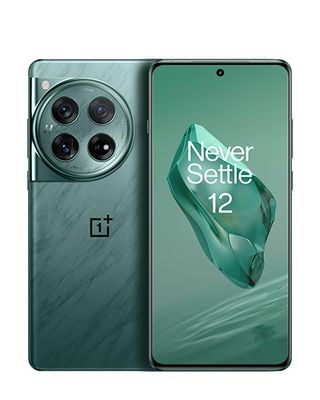
Killer value
OnePlus is at its best when it takes on bigger companies and comes out ahead, and that's what it is doing with the OnePlus 12. The phone has a gorgeous design that stands out, one of the brightest AMOLED panels of any device, the latest Qualcomm hardware with the ability to play games at 120fps, a larger battery that goes up to two days, and 100W charging tech — there's even 50W wireless charging this time around. But it's the cameras where there is a huge difference from last year, with OnePlus delivering a versatile camera package that takes outstanding photos in just about any situation. Ultimately, the OnePlus 12 is the best choice if you want a value-focused flagship that doesn't miss out in any area.
For
- Sublime AMOLED display
- Terrific gaming performance
- Battery lasts up to two days
- Alert slider is intact
- Gorgeous design
- 100W charging and 50W wireless charging
- Much better cameras than last year
Against
- No IP68 ingress protection
- Not as good as the iPhone at shooting videos
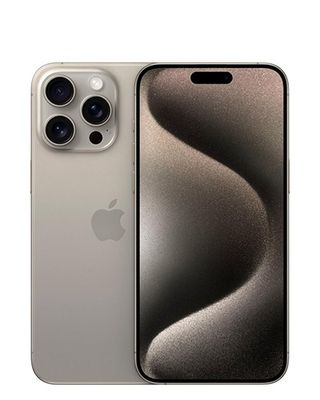
Killer pricing
The iPhone 15 Pro Max continues to be a phenomenal phone, and it ticks all the right boxes. The switch to USB-C charging makes it easier to use, and the titanium chassis is lighter and thinner than its predecessors. The A17 Pro delivers outstanding performance in daily use, you get much better battery life than previous years, and the cameras are terrific. There isn't a whole lot missing here, but the downside is that the phone is one of the costliest around. If that isn't an issue, the iPhone 15 Pro Max is still a good recommendation.
For
- USB-C charging as standard
- Titanium design is thinner and lighter
- Outstanding performance
- Customizable Action Button
- Incredible battery life
- Standout cameras
- IP68 ingress protection
Against
- Twice as costly as the OnePlus 12 in select markets
- Throttles during extended gaming sessions
- Slower charging, no charger in the box
OnePlus 12 vs. iPhone 15 Pro Max: Design
Why you can trust Android Central
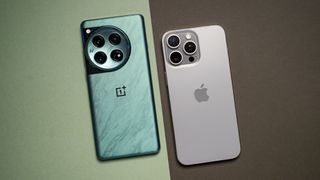
Apple isn't known for changing the designs of its phones, and the result is that the iPhone 15 Pro Max looks nearly the same as its predecessor, which was identical to its predecessor, and so on. But what's different this time is the switch to a titanium mid-frame, and this allowed the brand to considerably reduce the weight and size of the device. The titanium portion only covers the outer section of the phone, and a bulk of the mid-frame is made out of aluminum.
That said, the sheen of the titanium gives the phone a different look, and it's great to hold and use. But what I like best is the fact that it's lighter and thinner than previous years, and this makes it almost comfortable to use. The camera housing at the back is unchanged, but it is still instantly recognizable, and that counts for a lot.

OnePlus, meanwhile, isn't afraid to introduce bold designs, and the OnePlus 12 has a new Flowy Emerald finish that looks fabulous. The green hue immediately grabs attention, and the camera module is larger than last year and uses the same green color inside. The camera modules have individual rings now, and they highlight the modules a little better, and the overall design looks more polished than last year.
The OnePlus 12 has the same smooth curves as its forebears, and it makes holding and using the device a lot easier. While the iPhone 15 Pro Max isn't as unwieldy, it still has flat sides, and I like the design and in-hand feel of the OnePlus 12 a little better.
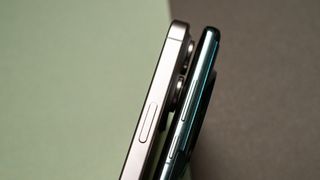
OnePlus continues to offer the alert slider, but it is now located on the left of the phone. The toggle lets you easily switch between ring, vibrate, and silent modes, and is a nifty addition. The iPhone 15 Pro Max has a new Action Button that's much more customizable than the mute toggle from previous years; the button lets you launch actions, switch Focus modes, toggle between ring and silent modes, and is one of my favorite features on the device.
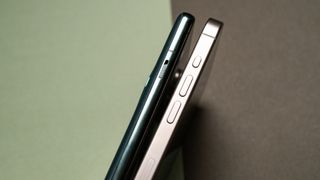
Where the iPhone 15 Pro Max also wins out is ingress protection. It offers IP68 dust and water resistance as standard, and is able to be submerged in up to six meters of water. The OnePlus 12, on the other hand, has IP65, and you miss out on protection from water ingress.
To sum it up, the iPhone 15 Pro Max still has a design that's recognizable the world over, and the OnePlus 12 introduces a bold aesthetic that looks terrific.
OnePlus 12 vs. iPhone 15 Pro Max: Display

Both phones have outstanding displays, but the OnePlus 12 takes things to a new level with its 6.82-inch AMOLED panel. It has a higher 3168 x 1440 resolution, but where it stands out is the brightness levels — the panel is able to hit 4,500 nits in HDR content, going up to 1,600 nits in HBM mode.
The iPhone 15 Pro Max goes up to a maximum of 2,000 nits in HBM mode, but where it excels is in daily use; its OLED panel is brighter in most daily usage scenarios, and that makes a difference. The screen is marginally smaller at 6.7 inches, and the 2796 x 1290 resolution is more than adequate.

I don't have any issues with the panels on these devices, and they both sport 120Hz refresh with dynamic scaling that adjusts the refresh based on the content on the screen. They both have Dolby Vision, and they hold up incredibly well for gaming; the iPhone 15 Pro Max has the edge in this area as it is able to play demanding games at 120fps with ease, and although the OnePlus 12 uses a custom Pixelworks chip that allows the device to hit the same 120fps in all games, it doesn't actually show up in real-world use.

The iPhone 15 Pro Max has even thinner bezels than last year, and the highlight at the front is the Dynamic Island, the interactive cutout that highlights useful information. The pill-sized cutout is significantly larger than what you get on the OnePlus 12, but you get a decent amount of usability out of it. Talking about the OnePlus 12, the phone has a selfie camera cutout located in the center now.
OnePlus delivers better customizability with the always-on mode and adjusting the color balance of the panel, and what the iPhone 15 Pro Max lacks in customization it makes up for in useful features. The TrueTone engine does a great job changing the color balance based on ambient light, and the Screen Distance mode reduces eye strain by sending alerts whenever you're holding the phone too close to your face.
OnePlus 12 vs. iPhone 15 Pro Max: Hardware
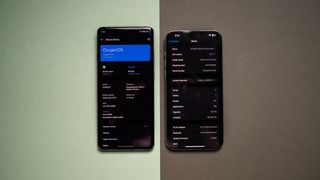
Like the best Samsung phones, the OnePlus 12 is powered by the latest Snapdragon 8 Gen 3, delivering outstanding performance in daily use as well as gaming. You don't see any slowdowns or lag whatsoever, and the interface is fluid. The phone comes with 12GB of RAM and 256GB of storage as standard, and there's also a 16GB/512GB version if you need more storage.
Although OnePlus has a 1TB model, that variant is limited to China, and isn't available in other markets. That isn't an issue with the iPhone 15 Pro Max, which starts at 256GB (thankfully), and is available in 512GB and 1TB versions. I'm using the 1TB variant, and it definitely comes in handy when shooting Dolby Vision videos.
| Category | OnePlus 12 | iPhone 15 Pro Max |
|---|---|---|
| OS | OxygenOS 14 based on Android 14 | iOS 17.1.2 |
| Display | 6.82-inch 120Hz LTPO AMOLED (3168x1440), HDR10+, Dolby Vision, 1,600 nits (HBM), 4,500 nits (HDR), Gorilla Glass Victus 2 | 6.7-inch OLED 120Hz, 2796x1290, Dolby Vision, HDR10, 2000 nits max |
| Chipset | Snapdragon 8 Gen 3, Adreno 750, 4nm | A17 Pro, 3nm |
| RAM | 12GB/16GB LPDDR5X | 8GB |
| Storage | 256GB/512GB UFS 4.0 | 256GB/512GB/1TB |
| Rear camera 1 | 50MP f/1.6 Sony LYT-808, 1/1.4-inch sensor, 23mm focal length, OIS, 8K at 30fps | 48MP f/1.8, 1/1.28-inch sensor, PDAF, OIS, 4K at 60fps, Dolby Vision |
| Rear camera 2 | 64MP f/2.6 OmniVision OV64B telephoto, 1/2-inch sensor, 70mm to 140mm focal length, 3x optical zoom, 6x in-sensor zoom, 120x digital zoom, OIS | 12MP f/2.2 wide-angle, 1/2.55-inch sensor, 120-degree FoV |
| Rear camera 3 | 48MP f/2.2 Sony IMX581 wide-angle, 1/2-inch sensor, 14mm focal length, 114-degree FoV | 12MP f/2.8 telephoto, 5x optical zoom, OIS |
| Front camera | 32MP f/2.4 Sony IMX615, 1/2.74-inch sensor, 21mm focal length | 12MP f/1.9, PDAF, OIS |
| Ingress protection | IP65 dust and water resistance | IP68 dust and water resistance, 6m up to 30 minutes |
| Connectivity | Wi-Fi 7, Sub-6 5G bands, NFC, Bluetooth 5.4 | Wi-Fi 6E, Bluetooth 5.3, NFC, UWB, 5G, Emergency SOS |
| Security | In-screen optical sensor | Face ID |
| Audio | USB-C, stereo sound, 32-bit/384KHz, AptX HD, AptX, LDAC, LHDC, AAC, SBC | USB-C, stereo sound |
| Battery | 5400mAh battery, 100W SuperVOOC, 50W AirVOOC wireless charging | 4441mAh, 20W charging, 15W MagSafe |
| Dimensions | 164.3 x 75.8 x 9.1mm, 220g | 159.9 x 76.7 x 8.3mm, 221g |
| Colors | Flowy Emerald, Silky Black | Natural Titanium, Blue Titanium, White Titanium, Black Titanium |
The iPhone 15 Pro Max is powered by the A17 Pro, and it is the fastest mobile platform around. It has excellent gaming potential and is overkill in most daily tasks, and in all the time I used the phone, I didn't once get the feeling that it was lacking in power.

Both phones have extensive connectivity options, with the OnePlus 12 offering a Wi-Fi 7 modem, Bluetooth 5.4, AptX HD and LHDC codecs. The iPhone 15 Pro Max has a Wi-Fi 6e modem, Bluetooth 5.3, and you don't get much in the way of AptX codecs, as that's Qualcomm tech. What is interesting is the switch to USB-C with this generation, and the phone has a full-fledged USB 3.2 Gen 2 slot, and you get DisplayPort out, making it easy to connect to an external monitor.

OnePlus has been stingy with USB-C connectors in the past, but the OnePlus 12 uses the USB 3.2 standard, and that's a good thing. But when it comes to the extras, the iPhone 15 Pro Max has a lot more on offer; you get UWB 2, crash detection, and Emergency SOS via satellite.
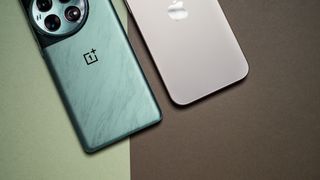
Switching over to the battery, the OnePlus 12 has a massive 5400mAh battery that lasts up to two days with medium use. Alongside the large battery, you get 100W charging tech that takes just over 30 minutes to charge the battery, and there's even 50W wireless charging this time, along with 10W reverse charging.
The iPhone 15 Pro Max has a considerably smaller 4441mAh battery, but it manages to last over a day with relative ease. Where it loses out is the charging; you don't get a charger in the box, and the phone only goes up to 30W charging, taking considerably longer to charge the battery. That said, the StandBy mode is useful when using a MagSafe charger like the UGREEN 2-in-1 charging stand.
OnePlus 12 vs. iPhone 15 Pro Max: Cameras

Cameras are the biggest differentiator in this category, and both phones have plenty to offer here. The OnePlus 12 uses a 50MP Sony LYT-808 camera module with a 1/1.4-inch sensor and OIS, and it's joined by a 64MP OmniVision OV64B telephoto lens with OIS that has 3x optical zoom. There's also a 48MP Sony IMX581 module that serves as the wide-angle lens, and it has autofocus this time, allowing it to double as a macro shooter. You get a 32MP Sony IMX615 selfie camera, and it doesn't have autofocus.
The iPhone 15 Pro Max has new camera hardware as well, with the phone touting a 48MP main camera with second-gen sensor-shift stabilization and the ability to change focal lengths. The phone also has a 12MP telephoto lens with OIS that hits 5x optical zoom, and there's a 12MP wide-angle lens that is also the de facto macro shooter.
There's a ton of shooting modes and effects available on either device, and what I like about the iPhone 15 Pro Max is the ability to add background blur after a photo is taken. The OnePlus 12 leverages its Hasselblad integration to full effect, rolling out custom modes and a watermark feature that highlights the Swedish brand's involvement.
Photos taken with both phones are outstanding, and you get daylight shots with plenty of detail and color vibrancy. The OnePlus 12 manages to deliver shots that are just as good as the iPhone, and that's no small feat. It's a close contest in low-light situations as well, with the OnePlus 12 taking terrific photos. The iPhone 15 Pro Max still has an edge in this area, but it is a slender lead.
But the one thing the iPhone 15 Pro Max does better than most other phones is video recording; you get good stabilization and dynamic range, and all three sensors deliver a similar caliber of footage. You don't quite get that on the OnePlus 12, but other than that, it is just as good.
OnePlus 12 vs. iPhone 15 Pro Max: Software

The OnePlus 12 runs OxygenOS 14 based on Android 14 out of the box, and there really isn't much to talk about in this area. It has all the new features Google introduced in Android 14, and other than a slight change in fluidity and general stability, you don't notice much in the way of difference to the previous version of OxygenOS.
The interface is heavily customized, and it continues to be identical to ColorOS. That said, you get a lot of configurability, and unlike the last two years, the phone actually feels stable in daily use. As for updates, the phone will pick up four Android OS updates and five years of security patches.
The iPhone 15 Pro Max runs iOS 17 out of the box, and it doesn't have much in the way of notable new features either. While iOS doesn't have anywhere close to the same level of customizability as Android, it is immediately familiar — on account of most UI elements not being altered for several years — and although it is in need of an overhaul, it is stable and fluid.
I've had issues with notification management in previous iterations of iOS, but thanks to Focus modes, that isn't a problem these days. Overall, there is a lot to like in iOS, and if you're like me and are heavily invested in Google's ecosystem, you'll find that all the utilities are available on the iPhone as well, and they're just as good.
On the subject of updates, the iPhone 15 Pro Max should get at least five platform updates, making it one more than the OnePlus 12.
OnePlus 12 vs. iPhone 15 Pro Max: Which should you buy?
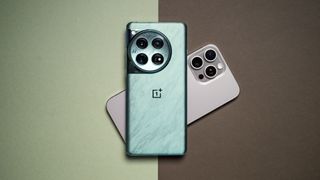
You're obviously getting two stellar phones here, and choosing between the two comes down to what you need in a phone. If you're used to iPhones and are looking to upgrade, the iPhone 15 Pro Max is the obvious choice; it has amazing hardware, a vibrant OLED screen with terrific colors, much better cameras at the back, battery that lasts longer, and the latest software features — all encased in a titanium shell that feels wonderful to hold and use.
If you're partial to Android, there is a lot to like with the OnePlus 12. The phone has a gorgeous design that is sure to turn heads, the hardware is among the best in this segment, you get a huge battery that's designed to last up to two days, and cameras that hold their own against the best phones available today.
There isn't anything inherently wrong with either device; regardless of whichever phone you buy, you'll be satisfied with the choice. But there's one additional thing to take into account, and that's the price. With the hardware on offer, neither device is affordable, but the OnePlus 12 starts off at $799, and that's a good overall value considering the caliber of the cameras and everything else you're getting.

Coming to the iPhone 15 Pro Max, you'll need to shell out $1,199 to get your hands on the 256GB version of the device, or $400 more than what you end up paying for the OnePlus 12. Things are a bit different outside the U.S. In the U.K., the OnePlus 12 costs £849 ($1,068), and over in India, the phone retails for ₹64,999 ($785).
The iPhone 15 Pro Max costs £1,199 ($1,509) in the U.K., or $440 more than what the equivalent OnePlus 12 costs in the region. But it's in India where things get truly ridiculous, with the iPhone 15 Pro Max starting out at ₹1,59,900 ($1,927). You can get two 521GB variants of the OnePlus 12 for that amount of cash, and have enough money left over to get OnePlus Buds 3 and the OnePlus Keyboard 81.
Choosing between the two in the U.S. is straightforward; you don't need to pay the entire asking price upfront, so the iPhone 15 Pro Max is the obvious choice. But everywhere else, the OnePlus 12 just makes much more sense. I have both phones with me, and for my own use, I'd go with the iPhone 15 Pro Max — as much as I like the design of the OnePlus 12, I'm still not sold on the software, and the iPhone has a bit more polish in this area.
But if I had to buy a phone with my own money, I'd just get the OnePlus 12. Sure, it isn't as good as the iPhone 15 Pro Max in a few areas, but it is much more affordable while nailing the basics, and that's good enough for me.

Killer value
OnePlus did all the right things with the OnePlus 12. The phone has a stunning design, great hardware, terrific cameras, and long-lasting battery. Combine all of that with the best value in this category, and it is an easy recommendation.

Killer pricing
Picking up the iPhone 15 Pro Max is all about what you need in a phone. There's clearly a lot to like here; the titanium chassis is wonderful to use, you get one of the best hardware packages around, there are plenty of unique software utilities and games, and the cameras are fantastic. But the biggest downside is the price; the iPhone 15 Pro Max just costs too much outside North America.
Be an expert in 5 minutes
Get the latest news from Android Central, your trusted companion in the world of Android

Harish Jonnalagadda is a Senior Editor overseeing Asia at Android Central. He leads the site's coverage of Chinese phone brands, contributing to reviews, features, and buying guides. He also writes about storage servers, audio products, and the semiconductor industry. Contact him on Twitter at @chunkynerd.
